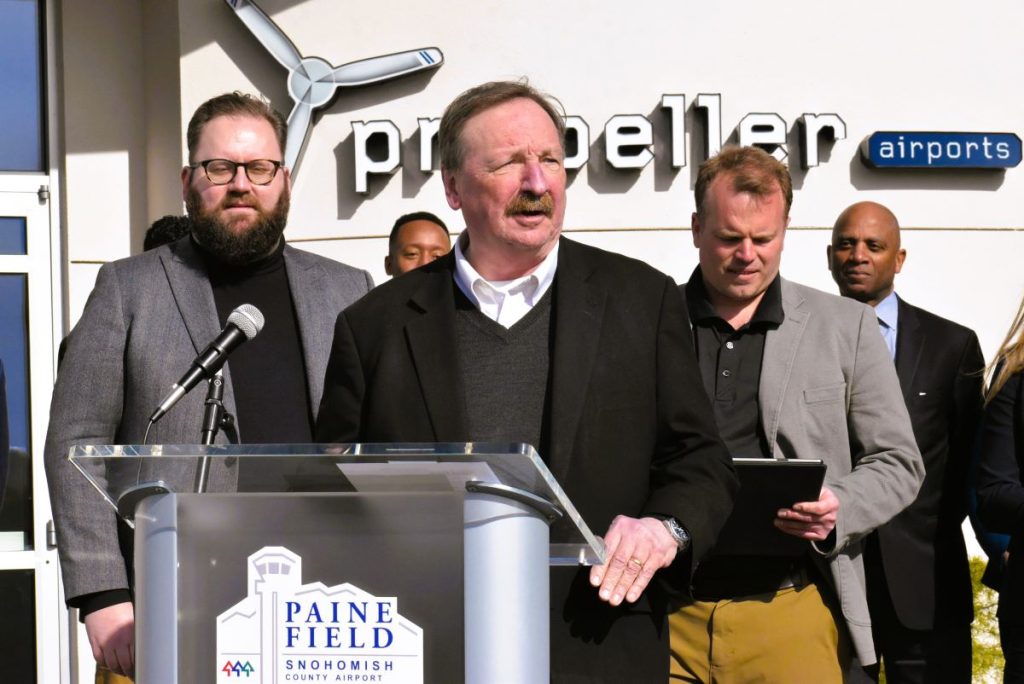EVERETT—The ball is rolling on Paine Field’s new Sustainable Aviation Fuel (SAF) Research and Development Center as the repository prepares to break ground later this year, with a later, permanent facility currently entering its planning phase.

SAF’s are a biofuel with similar properties and safety requirements as conventional jet fuel used in aircraft but with a smaller carbon footprint. These certified “Jet-A1” fuels are made by blending conventional kerosene (fossil-based) with renewable hydrocarbon. Currently, SAFs are used as a “drop-in” replacement to conventional petroleum-based jet fuel that when combined is called a blend. The minimal acceptance blend is 10% SAF to a high of 50%. The goal is a certified 100% replacement blend of SAF to conventional jet fuel.
A huge benefit to SAFs than alternative green aviation solutions such as electric and hydrogen powered aircraft fleets is the minimal disruption to implement into existing infrastructure. It is cost beneficial to ensure that manufacturers do not have to redesign engines nor aircraft, and that fuel suppliers and airports do not have to build new fuel delivery systems.
The R&D Center is made possible through a partnership with Washington State University (WSU) and will be the world’s first-ever SAF repository of its type for advancing sustainable aviation fuel technologies and serve the global needs for reference samples to support research, the county says. The Center will also be the only facility to collect, sample, and distribute SAF at a scale needed for widespread use in the largest aircrafts.
In its current state the project has successfully secured State Department funds to begin construction on the repository and completed a business plan late 2023 with the assistance of William Gary – a consultant hired through the county’s partnership with Aerospace Futures Alliance. Gary has worked on several research and development projects including Oregon’s Manufacturing and Innovation Center and Sheffield in the United Kingdom.
Start-up funding comes from a Senator Marko Liias-backed $6.5 million proviso proposal in the State Senate Transportation Budget published last year, with the consultant and business plan funding amount of, around $30 thousand, coming out an ongoing state Commerce fund.

One of the first orders of business last year was to locate a plot of land for both the repository and permanent facility, both of which have now been identified. The permanent facility is shovel-ready, Simreet Dhaliwal, Project Manager for the SAF R&D Center, informed the Lynnwood Times in a phone interview Tuesday, and will be located right off Bernie Webber Drive, adjacent to terminal. The repository, which will act as a temporary facility while the permanent facility undergoes construction, will also be at Paine Field.

“We’re doing our best to ensure there’s due diligence in preparing a product and facility that’s going to be beneficial to both our researchers and private industries,” said Dhaliwal. “That’s the county’s goal; to make sure we’re meeting those needs while also supporting our workers and businesses that are already here.”
The actual specifications of the permanent facility, as far as size and square footage, have yet to be determined but Dhaliwal explained many of the specific details will be determined during the project’s Design and Construction plan set to be completed later this year.
The repository, on the other hand, will have three tiers of storage with three to four 50,000 to 60,000-gallon tanks, 10 to 20 1,000-gallon tanks, and about 100 5-gallon tanks. The construction of the repository is expected to begin sometime this year spanning a 3-to-6-month process contingent on expected supply chain issues, as far as procuring the storage tanks.
The centers will be focused primarily on storing, testing and blending SAF (to see if the product qualifies for FAA standards), not necessarily production. Whether production becomes a priority of both facilities in the future depends on private investors, the county said.
“The county’s goal is to ensure this facility remains a lead in SAF and clean technology just generally, so that’s where our focus will be. If production is a need that is identified through our further work with private industry, then we’ll look into it but that [decision] is kind of out of our wheelhouse,” said Dhaliwal.

As far staff members working there, the county is looking at utilizing a membership-based system between the county, Washington State University, and other private industry partners. WSU will be sending researchers out to conduct work at both the repository as well as the eventual permanent facility. The county, while looking forward to being a member of both facilities, does not foresee employing any county staff.
“We don’t have a specific number [of how many people will be working there at one time] but we do believe we are going to generate a considerable number of jobs and investments through the center,” said Dhaliwal.
If all goes according to plan the county says the permanent facility could see an opening from anywhere between 2027 and 2029, though with capital projects like this which often undergo unforeseen setbacks, the actual date has yet to be determined. Once the permanent facility finally opens, the county will be incorporating all of the work conducted at the temporary facility, within the repository in the meantime.
“We have received a lot of positive feedback from our community as well as our elected officials,” said Dhaliwal. “Our partners at the federal level have been supportive, as well as at the local, and state levels. The community in general have been really interested. We hopefully continue to have people invested because the jobs and investment that are going to come out of this will be very beneficial across the county.”
Kelsey Nyland, Snohomish County’s Office of Recovery and Resilience Director of Communications, added that a lot of excitement has been generated among the county’s labor partners – such as machinists – as well as school districts, which is important to generate STEM workforce pipelines.
Snohomish County’s Paine Field Airport, a major hub of aviation and aerospace in the region, supports over 158,000 jobs and generates nearly $60 billion annually for the economy, Executive Sommers said Tuesday. However, the continued success of commercial aviation depends on addressing the industry’s carbon emissions that contribute to global climate change he added.
In Snohomish County, aviation is estimated to have accounted for 5% of Snohomish County’s total community-wide greenhouse gas emissions in 2019, which represents a 23% increase from 2015 levels, according to the county.
Paine Field was determined to be the ideal location for the upcoming SAF R&D Center due to its proximity to the production of medium and long-haul aircraft—planes that seat at least 100 passengers and fly at least 150 minutes. These aircraft make up 73% of carbon emissions in commercial aviation.
In 2022 Sen. Liias led the effort in passing the State’s $16 billion Move Ahead Washington Transportation package premised on decarbonizing Washington’s transportation sector while growing the economy. That package included funding for sustainable aviation which aligns with the R&D’s objectives.
The Snohomish County Executive’s Office have been also working with U.S. Representative Rick Larsen, who is the Ranking Member on the House Transportation & Infrastructure Committee, and U.S. Senators Patty Murray and Maria Cantwell for federal backing.
With the R&D Center for SAF, the County and its partners hope to change the industrial landscape by leading the world in the development, distribution, and adoption of new technologies to reduce the economy’s dependence on carbon-based fuels. It plans to achieve this goal by testing SAF samples, investigating SAF production methods and its impacts on human health and the environment, and testing SAF samples large scale (by the thousands of gallons) needed to ensure safety and bring new fuels and products to the market.




















One Response